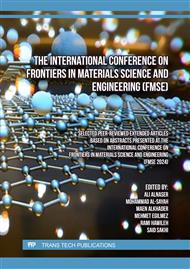[1]
B.V. Ramnath, K. Alagarraja, C. Elanchezhian, Review on sandwich composite and their applications, Mater Today Proc 16 (2019) 859–864.
DOI: 10.1016/j.matpr.2019.05.169
Google Scholar
[2]
O. Al Osman, M. Alkhader, W. Abuzaid, Dynamic compressive response of coated open-cell aluminum foam, (2022) 1–4.
DOI: 10.1109/ASET53988.2022.9734946
Google Scholar
[3]
F. Xia, Y. Durandet, P.J. Tan, D. Ruan, Three-point bending performance of sandwich panels with various types of cores, Thin-Walled Structures 179 (2022) 109723. https://doi.org/.
DOI: 10.1016/j.tws.2022.109723
Google Scholar
[4]
M.M. Sychov, L.A. Lebedev, S. V Dyachenko, L.A. Nefedova, Mechanical properties of energy-absorbing structures with triply periodic minimal surface topology, Acta Astronaut 150 (2018) 81–84.
DOI: 10.1016/j.actaastro.2017.12.034
Google Scholar
[5]
F. Cote, V.S. Deshpande, N.A. Fleck, A.G. Evans, The out-of-plane compressive behavior of metallic honeycombs, Materials Science and Engineering: A 380 (2004) 272–280.
DOI: 10.1016/j.msea.2004.03.051
Google Scholar
[6]
L.L. Yan, B. Yu, B. Han, C.Q. Chen, Q.C. Zhang, T.J. Lu, Compressive strength and energy absorption of sandwich panels with aluminum foam-filled corrugated cores, Compos Sci Technol 86 (2013) 142–148.
DOI: 10.1016/j.compscitech.2013.07.011
Google Scholar
[7]
D.J. Sypeck, Cellular truss core sandwich structures, Applied Composite Materials 12 (2005) 229–246.
DOI: 10.1007/s10443-005-1129-z
Google Scholar
[8]
Y. Chen, R. Das, A review on manufacture of polymeric foam cores for sandwich structures of complex shape in automotive applications, Journal of Sandwich Structures & Materials 24 (2022) 789–819.
DOI: 10.1177/10996362211030564
Google Scholar
[9]
U. Farooq, M.S. Ahmad, S.A. Rakha, N. Ali, A.A. Khurram, T. Subhani, Interfacial mechanical performance of composite honeycomb sandwich panels for aerospace applications, Arab J Sci Eng 42 (2017) 1775–1782.
DOI: 10.1007/s13369-016-2307-z
Google Scholar
[10]
T. Bitzer, Honeycomb marine applications, Journal of Reinforced Plastics and Composites 13 (1994) 355–360.
DOI: 10.1177/073168449401300406
Google Scholar
[11]
R. Attarzadeh, S.-H. Attarzadeh-Niaki, C. Duwig, Multi-objective optimization of TPMS-based heat exchangers for low-temperature waste heat recovery, Appl Therm Eng 212 (2022) 118448.
DOI: 10.1016/j.applthermaleng.2022.118448
Google Scholar
[12]
A.P.G. Castro, R.B. Ruben, S.B. Gonçalves, J. Pinheiro, J.M. Guedes, P.R. Fernandes, Numerical and experimental evaluation of TPMS Gyroid scaffolds for bone tissue engineering, Comput Methods Biomech Biomed Engin 22 (2019) 567–573.
DOI: 10.1080/10255842.2019.1569638
Google Scholar
[13]
S. Yu, J. Sun, J. Bai, Investigation of functionally graded TPMS structures fabricated by additive manufacturing, Mater Des 182 (2019) 108021.
DOI: 10.1016/j.matdes.2019.108021
Google Scholar
[14]
W. Tang, H. Zhou, Y. Zeng, M. Yan, C. Jiang, P. Yang, Q. Li, Z. Li, J. Fu, Y. Huang, Analysis on the convective heat transfer process and performance evaluation of Triply Periodic Minimal Surface (TPMS) based on Diamond, Gyroid and Iwp, Int J Heat Mass Transf 201 (2023) 123642.
DOI: 10.1016/j.ijheatmasstransfer.2022.123642
Google Scholar
[15]
D. Weber, S. Srinivas Sundarram, 3D‐printed and foamed triply periodic minimal surface lattice structures for energy absorption applications, Polym Eng Sci 63 (2023) 1133–1145.
DOI: 10.1002/pen.26270
Google Scholar
[16]
Y. Zhong, Z. Shi, Q. Luo, M. Zhang, A simplified semi-analytical model for predicting the global and local responses of hybrid honeycomb-like sandwich panel, Thin-Walled Structures 182 (2023) 110307.
DOI: 10.1016/j.tws.2022.110307
Google Scholar
[17]
A. Vaziri, Z. Xue, J.W. Hutchinson, Metal sandwich plates with polymer foam-filled cores, J Mech Mater Struct 1 (2006) 97–127.
DOI: 10.2140/jomms.2006.1.97
Google Scholar
[18]
Y. Sun, R. Burgueño, A.J. Vanderklok, S.A. Tekalur, W. Wang, I. Lee, Compressive behavior of aluminum/copper hybrid foams under high strain rate loading, Materials Science and Engineering: A 592 (2014) 111–120.
DOI: 10.1016/j.msea.2013.10.104
Google Scholar
[19]
M. Sadighi, S.A. Hosseini, Finite element simulation and experimental study on mechanical behavior of 3D woven glass fiber composite sandwich panels, Compos B Eng 55 (2013) 158–166.
DOI: 10.1016/j.compositesb.2013.06.030
Google Scholar
[20]
T. George, V.S. Deshpande, K. Sharp, H.N.G. Wadley, Hybrid core carbon fiber composite sandwich panels: Fabrication and mechanical response, Compos Struct 108 (2014) 696–710.
DOI: 10.1016/j.compstruct.2013.10.002
Google Scholar
[21]
M. Alkhader, M. Vural, An energy-based anisotropic yield criterion for cellular solids and validation by biaxial FE simulations, J Mech Phys Solids 57 (2009) 871–890.
DOI: 10.1016/j.jmps.2008.12.005
Google Scholar
[22]
N.A. Fleck, X. Qiu, The damage tolerance of elastic–brittle, two-dimensional isotropic lattices, J Mech Phys Solids 55 (2007) 562–588.
DOI: 10.1016/j.jmps.2006.08.004
Google Scholar
[23]
T.G. Nieh, K. Higashi, J. Wadsworth, Effect of cell morphology on the compressive properties of open-cell aluminum foams, Materials Science and Engineering: A 283 (2000) 105–110.
DOI: 10.1016/s0921-5093(00)00623-7
Google Scholar
[24]
C. Chen, T.J. Lu, N.A. Fleck, Effect of imperfections on the yielding of two-dimensional foams, J Mech Phys Solids 47 (1999) 2235–2272.
DOI: 10.1016/s0022-5096(99)00030-7
Google Scholar
[25]
H. Jiang, Y. Ji, Y. Hu, X. Hu, Y. Ren, Interfacial design and flexural property of CFRP/aluminum-honeycomb sandwich with Aramid-pulp micro/nano-fiber interlays, Compos Struct 289 (2022) 115486.
DOI: 10.1016/j.compstruct.2022.115486
Google Scholar
[26]
L. Wahl, S. Maas, D. Waldmann, P. Frères, : Eurocomposites, Shear Stresses in Honeycombs Shear Stresses in Honeycomb Sandwich Plates: Analytical Solution, FEM and Experimental Verification, (2011).
DOI: 10.1177/1099636212444655
Google Scholar
[27]
T. Allen, N. Martinello, D. Zampieri, T. Hewage, T. Senior, L. Foster, A. Alderson, Auxetic foams for sport safety applications, Procedia Eng 112 (2015) 104–109.
DOI: 10.1016/j.proeng.2015.07.183
Google Scholar
[28]
A.-J. Wang, D.L. McDowell, In-plane stiffness and yield strength of periodic metal honeycombs, J. Eng. Mater. Technol. 126 (2004) 137–156.
DOI: 10.1115/1.1646165
Google Scholar
[29]
G. Palomba, T. Hone, D. Taylor, V. Crupi, Bio-inspired protective structures for marine applications, Bioinspir Biomim 15 (2020) 056016.
DOI: 10.1088/1748-3190/aba1d1
Google Scholar
[30]
L.L. Hu, T.X. Yu, Dynamic crushing strength of hexagonal honeycombs, Int J Impact Eng 37 (2010) 467–474.
DOI: 10.1016/j.ijimpeng.2009.12.001
Google Scholar
[31]
O. Al-Osman, M. Alkhader, W. Abuzaid, Enhancing the multifunctionality of open-cell foams through tailoring their thermal and mechanical properties using coatings, European Journal of Mechanics-A/Solids 99 (2023) 104923.
DOI: 10.1016/j.euromechsol.2023.104923
Google Scholar



